Replacing plugs with circuit breakers in an old dashboard - how to correctly do it yourself
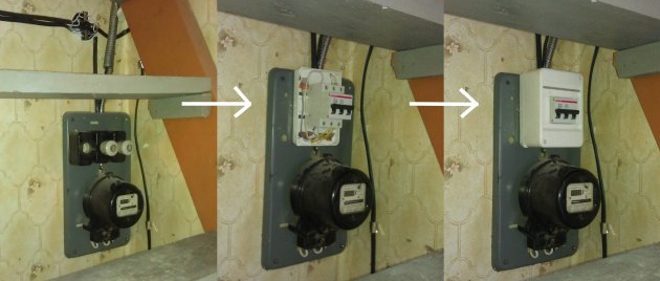
Electrical plugs are fuses that were previously installed in power grids, performing the role of protective devices in them. Often in old apartments there are still Soviet-style plug fuses installed on the meter. They can be ceramic or plastic. Electrical plugs are not highly reliable, and when they fail, a jumper is often placed in the shield, which passes current through itself, but does not save from a short circuit and the unpleasant consequences associated with it. To avoid problems, it is enough to change the plugs for circuit breakers. And in this article we will talk about how to replace plugs with machines with your own hands.
Content
Features of the choice of circuit breakers and power cable
Sometimes people, having come to the conclusion that it is necessary to replace old safety elements, install automatic plugs instead. This is due to the interchangeability of these devices and the identity of the installation, so the replacement procedure can be done in the shortest possible time. But we do not recommend doing this. Although the circuit breaker and the automatic stopper have the same principle of operation, the reliability of the latter is rather low.

It is best to opt for circuit breakers - they are much better and more durable. In addition, they are presented in a wide range in stores, and it is not difficult to choose a protective device for any network.
Before talking about how old plugs are replaced with circuit breakers, we will figure out how to choose the right type of circuit breaker. To do this, you need to calculate what is the total power of electrical appliances included in the home network. An illustrative example in the video:
Let's say that the apartment has:
- Refrigerator (400 W).
- Hob (7000 W.)
- Microwave oven (1800 W).
- TV (200W).
- Washing machine (700 W).
- Lighting devices (500 W).
Adding the power of all the listed devices, we get 10600W. The standard voltage in household networks is 220V. We calculate the load current according to the formula I = P / U, 10600/220 = 48.18A. Based on the ratings of commercially available machines, we can say that to protect such a network, you will need a 50A circuit breaker.
But that is not all. Before you put machines instead of electrical plugs, you need to make sure that the wiring is able to withstand the load that household appliances will give. To facilitate the selection of the cable cross-section, we give a table.
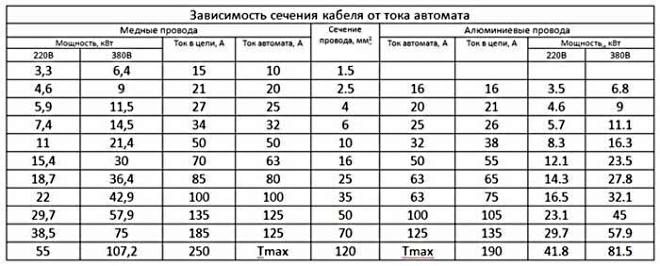
Based on the data presented, you can easily select the desired conductor cross-section. In our example, you need to choose a copper wire of 11 sq. mm or aluminum for 12.1 sq. mm.
Preparation for work
Another nuance of this procedure is working with a counter. Sometimes protective electrical plugs cannot be replaced with automatic machines without breaking the seals on the accounting device. If it was possible to do without this, the task is simplified, otherwise it is necessary to invite a representative of the energy supplying organization for sealing. Using an unsealed meter is prohibited by law, for such a violation a considerable fine is provided.
Instead of plugs, it is best to install an introductory two-pole circuit breaker. Sometimes the opinion is expressed that you can do with two single-pole machines, but in fact this is unacceptable.In this case, the phase and neutral conductors will be protected by different devices, and if the AB, set to neutral, is triggered, the phase current will continue to flow into the network, which can lead to fire. A two-pole device, upon detecting a malfunction, will disconnect both wires at the same time, de-energizing the circuit.
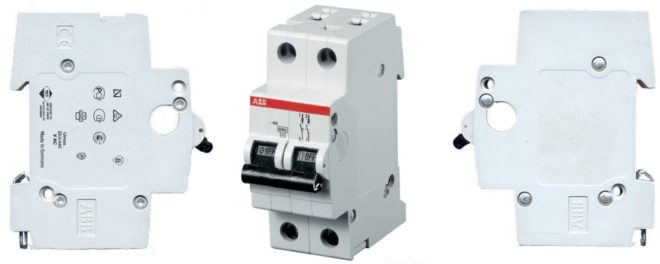
Before starting work, you need to locate the phase and neutral in the plugs with a multimeter or indicator screwdriver, having previously unscrewed them. Then turn off the power supply to the network - according to safety rules, it is prohibited to carry out installation work on the wiring to which the current is supplied. This is not only inconvenient, but also poses a real threat to health and life.
An example of replacing traffic jams with machines in the video:
Installation of circuit breakers
After the network is de-energized, work is performed in the following order:
- Remove the plugs for the electrical plugs.
- Install a DIN rail in their place. It must first be cut to match the size of the switch. Fastening to wood or metal with screws, and when working with a concrete wall, you need to use dowels.
- Connect the protective device. In this case, two current-carrying wires are connected from the top of the device (to avoid confusion, the letter N is applied to the terminal for connecting the neutral wire).
- From the bottom of the AB, you need to connect the cables through which electricity is supplied to the home network to the installed devices.
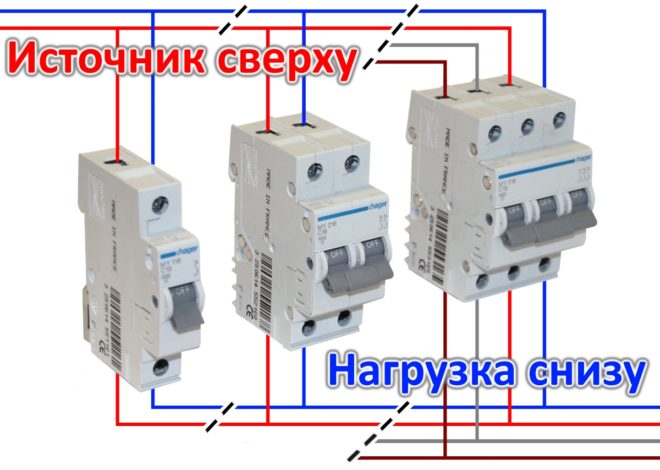
- After the conductors are connected, the safety switch is placed on the DIN rail.
This completes the replacement, but this scheme can be improved somewhat by making it safe for humans.
RCD connection
In order to prevent electric shock to people in case of accidental contact with a bare section of the cable, as well as in case of a breakdown on the case, it is advisable to include an RCD in the general network. The basis for the operation of the residual current device is the constant monitoring of the balance of the currents passing through the device. In the event of an electrical leakage to the housing or to the ground, an imbalance occurs. Having fixed the unbalance, the device is triggered and de-energizes the circuit.
The rated current of the RCD is selected in the same way as for the automatic input. The residual current device is connected to its output. It is recommended to check the operation of the RCD on a monthly basis - for this there is a "Test" button on the body of the device. From the output terminal of the device, the phase is connected to the input of the first AB, and then by means of jumpers it goes to other switches. Neutral cables must be connected together with a busbar and then secured to a DIN rail.
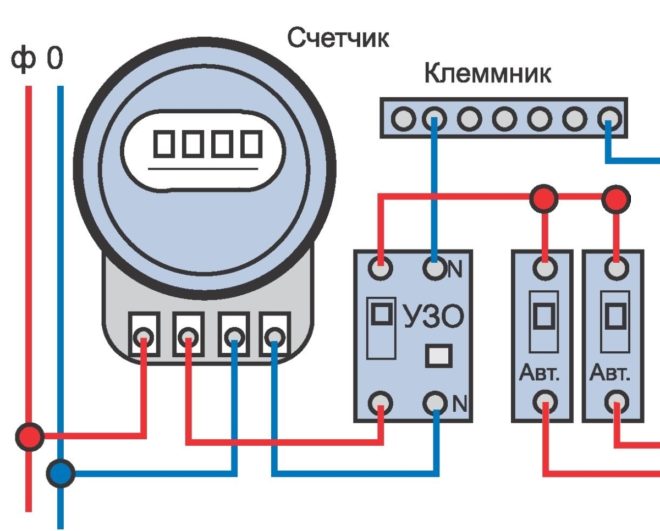
If the connection is three-wire, then the grounding conductors are connected in the same way with a busbar block. Note, however, that they should not be in contact with zero.
Conclusion
From the presented material, you learned how to choose network protection switches and how to replace plugs with automatic machines. Using our advice, you can do it yourself without resorting to the services of specialists and saving money.




